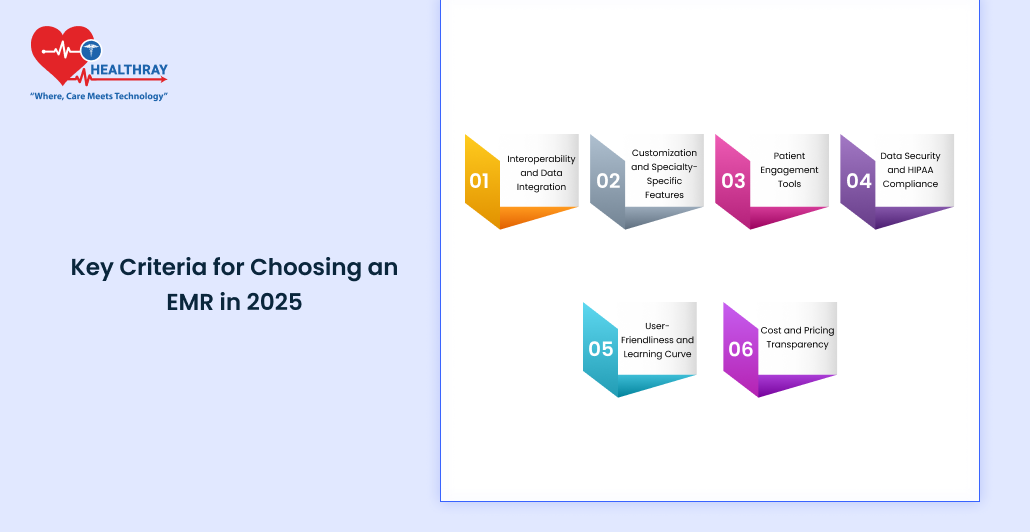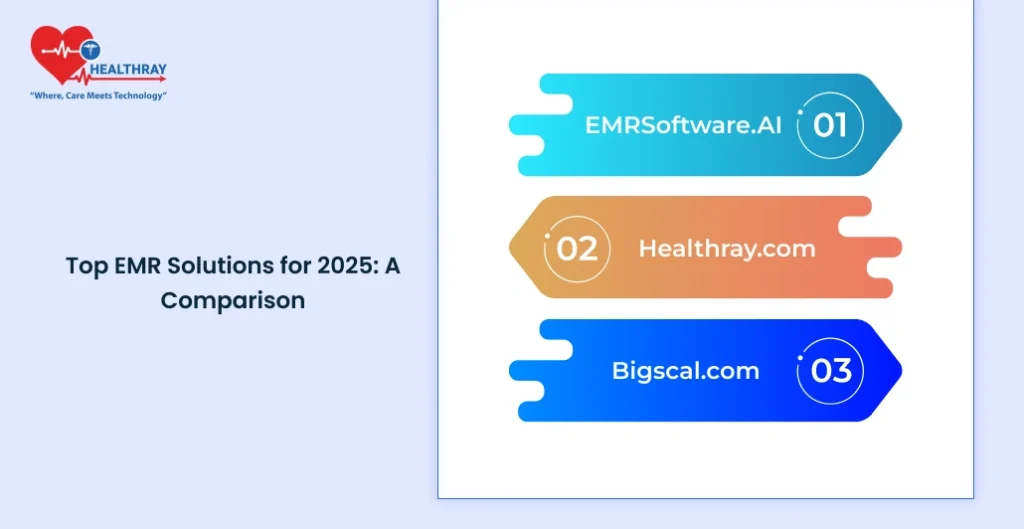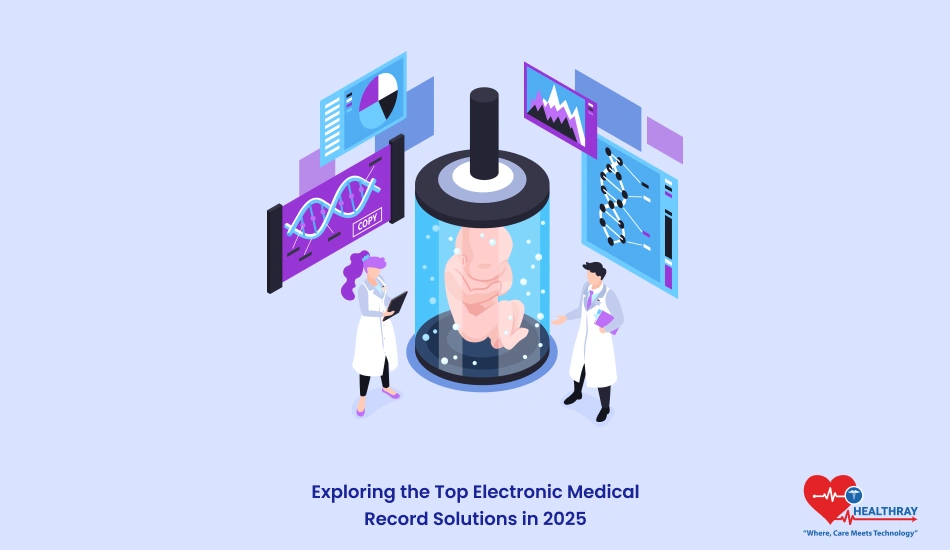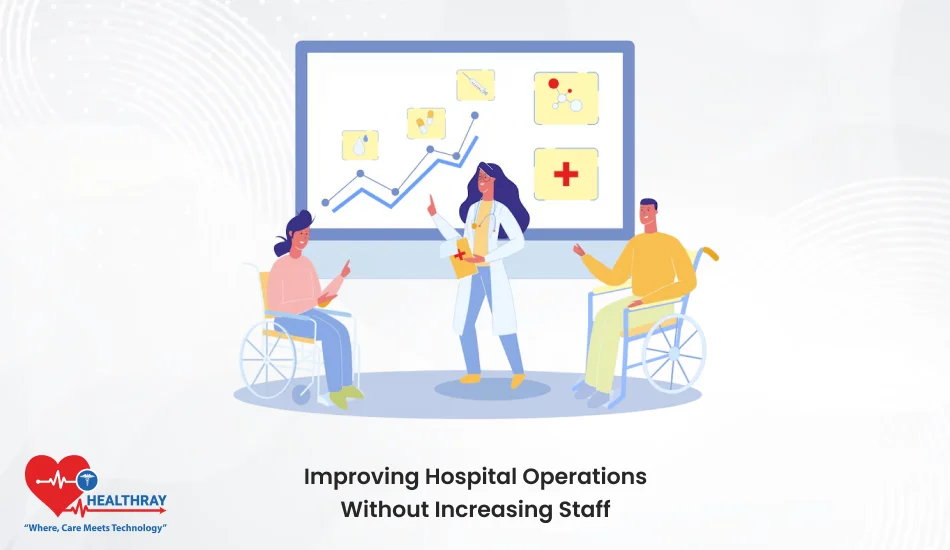Introduction
It is a pretty big decision in 2025, when there are just so many options available, to choose the right EMR software. With all the advancement in healthcare technology, EMRs are no longer merely holding patient records; they are central to patient care, enabling smooth workflows, improving data security, and even supporting telehealth and patient portals. Not every EMR fits every practice, however.
Ideally, for healthcare administrators, IT managers, and physicians, the perfect EMR Software should make mundane activities of daily tasks easy, be reliable in interoperability, and provide robust patient engagement tools. In this guide, as we look at the best EMR systems of 2025, we have tried to break down the features, strengths, and considerations for each solution, and thus help you make a decision that best suits your unique needs and budget.
Key Selection Criteria for an EMR in 2025

This extends beyond a technology decision that affects patient care, day-to-day business, and compliance with regulation. Top selection criteria in evaluating EMR systems as of 2025 include the following:
Interoperability and Data Integration
The ability of an EMR to easily connect to other health care systems is an essential aspect of effectiveness. This might include lab results, imaging, or connecting to patient portals. The interoperability of the system allows clinicians to access all necessary information regarding their patients in real time. This supports better decision-making and easier transitions of care.
Customization and Specialty-Specific Features
Not all practices are the same, so customization is paramount. Many of today’s top EMR solutions offer templates and workflows tailored to various specialties, such as pediatrics, behavioral health, or cardiology. Specialty-specific features can streamline tasks and improve care quality by fitting the software to your practice’s unique workflow.
Patient Engagement Tools
Patient portals, telehealth functionality, and automated appointment reminders are no longer a nicety. These will enable an empowered patient to be in control of their care, schedule appointments, review records, or see test results. So an engaged patient does better, making an EMR that supports easy communication highly valuable.
Data Security and HIPAA Compliance
Due to the rising health care data breaches every day, data security is one of the most important factors. Choose a system that has enough and robust security measures like encryption and multi-factor authentication for protecting sensitive patient data. The HIPAA-compliant systems help avoid fines and ensure maintaining the trust of the patients.
Ease of Use and Learning Curve
Complex EMR systems can become a thorn in the side of the personnel if they have to attend too much training. Well-designed friendly interfaces are preferable so that they take less amount of time and frustration, save both time and pain. Recently, many such streamlined layouts have been established by various systems that perform routine operations within a minimum number of clicks so the clinicians stay engaged with patients, not the software.
Cost and Pricing Transparency
The cost for EMRs does vary and based on a combination of factors ranging from the number of users down to the small practices, then even more specifically with additional extra features. However, if EMRs have specific clear tier pricing, it means the administrators should budget and even avoid surprise in cost. Sometimes free and low-cost basic tiers can be really what smaller-practice facilities or departments need best, while fully scaled packages better meet the comprehensive needs of greater facilities.
This is one of the reasons why cloud-based EMRs are appealing to most small to mid-sized practices as they are accessible and have low IT overhead. Larger institutions with dedicated IT staff tend to prefer on-premise systems for the control they are able to gain over deployment. When choosing an appropriate EMR, you will need to know what your needs are in terms of deployment so as to fit in well with the existing infrastructure.
Top EMR Solutions for 2025: A Comparison

Best EMR solutions of 2025: Top systems with unique strengths and features, and what you should be aware of. As we proceed through this list, it will help you make a better comparison of what each EMR might offer, and which might best match your objectives for your practice.
EMR Software. AI
Overview: EMRSoftware.AI is a highly expansive suite of EMR tools developed to support every wide range of healthcare needs-from the smallest practices to big hospital networks. Its solutions, based on cloud, mainly target data interoperability to interface with any health care system without hassles.
Key Features:
Interoperability: Integration of other health care tools to give an all-around view of patient care.
Virtual Nursing Tools: Point-of-care documentation would be one that reduces administrative burdens.
Analytics and Reporting: Through enhanced analytics capabilities, a more holistic understanding of clinical decision-making, data-driven as it now is, is supported.
Pros
Works well from small-sized to large-sized practices.
Strong on interoperability and data integration.
Cons
Medium to High upfront costs.
Healthray.com
Overview: Healthray.com remains the preference of big medical groups because of its total variety of features and its dependability. This EMR is very strong in devices that allow both for clinical and administrative needs, hence suits very well for complicated medical setups.
Key Features:
Customizable Interface: Specialty-specific workflows and templates.
Patient Portal: The patient is allowed to view his health record, request a refill, and communicate with his provider.
Telehealth Integration: It fosters out-of-office care by video consultations and other telehealth options.
Advantages
Modular architecture which provides customized configurations
Superb patient engagement tools
Disadvantages
Onboarding is quite lengthy and cumbersome
Bigscal.com
It is EMR all-in-one, practice management, and patient engagement software. It has availed the possibility to be very versatile as well as web-based, which makes it deployable easily and accessible to even the smallest or largest practices.
Key Features:
Integrated Telehealth: Provides online consultations as an in-app functionality to the patient.
Patient Engagement: Patient portal, appointment scheduling, and SMS appointment reminders.
Practice Management Features: Includes functionalities of billing, scheduling, and revenue cycle.
Benefits:
Has a comprehensive list of features for patient engagement as well as management.
Cloud-based, which allows access from a variety of devices.
Drawbacks:
The advanced features have extra costs.
Scalability and Deployment Options
Options in deploying would also affect how an EMR integrates into your practice. Knowing if it is best for your use cases the difference between cloud and on-premise makes things easier and allows ease of accessibility for data as well as options in flexibility in the long run. Now let’s have a look at some of the most deployed EMR System Software in relation to how they work.
Cloud-Based EMR Systems
Since EMRs are cloud-based, it stores the data of the practices online and provides remote access to the secure internet. The company of EMR takes care of the practice in regards to system maintenance and updates and data security for this system.
Advantages:
- Accessibility: A cloud-based system means a provider has access to information through a device at an office or from home, while also traveling. It is most convenient for telehealth providers.
- Cost-Effective: There is little to no upfront investment in a cloud-based system because no hardware needs to be set up in an office to serve a patient’s medical data and a small practice has easier estimation of their monthly charges through the subscription method.
- Automatic Updates and Security: Most cloud providers handle regular software updates and security enhancements, thereby reducing the need for in-house IT support.
Considerations:
Internet Dependency: The cloud-based EMRs require internet connection to allow for easy access. This may present as a limitation when internet reliability is not a guarantee.
Data Control: Because data is hosted outside, practice may have limited control over where the data is stored and needs to depend on the security protocols by the provider.
On-Premise EMR Systems
Although the on-premise systems are in the local servers of the practice, this model allows for a degree of control over the way data is dealt with but as high maintenance as it requires a dedicated team for IT support and maintenance.
Advantages:
- Data Control and Security: Better control over data is given with the on-premise systems. This might be a relatively big issue with big health institutes where sensitive information needs to be safeguarded based on the demands for security peculiar to that entity.
- Customisation Capability: Some feel this is more feasible on-premise EMR as they would be able to get access to all facets of the back end to be adapted according to specific individualized workflows and their unique requirements.
- Internet connectivity independence: the systems are independent of internet connectivity and may represent a viable solution for practices in areas with little under-connectivity or nonreliable connectivity.
Consideration factors:
Higher Initial Investment: On-premise systems cost much more on the initial level of investment for hardware, software, and IT infrastructure. Updating maintenance and security is also within the practice’s responsibility.
Continuous IT Support: These systems will require constant IT support to take care of the updates, troubleshoot, and data security problems.
Hybrid EMR Systems
Some of the EMR service providers are actually starting to offer hybrid solutions that integrate some of both of the cloud-based and on-premise systems. This would make it possible that sensitive information that should actually be stored within the premises system, whereas, for example, telehealth or a patient portal uses cloud storage for added accessibility.
Advantages
- Hybrids bring a great balance between on-premise flexibility with security, and control of that, coupled with cloud features of flexibility, accessibility, among other benefits.
- Scalable for Growth: The configuration is able to scale up with practice. There can be additions of features with the need to transition without compromising control over the data.
Considerations:
- Complex Setup: Hybrid systems are complex and hard to implement and require deep knowledge in IT about managing the two different environments of local and cloud.
- Cost Variability: Hybrid solutions will scale cost-effectively but the cost depends on which features, and which data storage options are chosen.
Pricing Models and Cost Concerns
Pricing for EMRs can be accessed on a broad basis that captures features, deployment type and practice size. Major pricing models are generally understood best if knowing what each usually entails can help avoid an expensive surprise when deciding to buy an EMR system.
Subscription-Based Pricing
- Core Features: More or less all essential EMR features are covered by a subscription model including patient record management, scheduling, and billing.
- Support and Maintenance: Secondly, most programs offer support as well as continual updates and upkeep of the system, thus lifting most of the IT burden off the practice’s shoulders.
- Additional Modules: A few will include some additional modules like telemedicine or enhanced reporting. More often than not, these are also available at a premium.
Examples: Systems like EMRSOFTWARE and Healthray offer subscription-based models for as low as affordable prices. Thus, it is an ideal choice for practice that requires adaptability without necessarily breaking the bank.
Tiered Pricing and Feature-Based Plans
Tiered pricing models group up different tiers of feature packages. This is beneficial for those practice types that do not require the most advanced features right away. They can start at a low tier then escalate as practice becomes more prominent.
What’s in the package:
- Basic, Mid, and Premium Plans: Most tiered plans range from basic (core features only) to premium (includes advanced features such as AI-driven analytics or telehealth).
- Scalable as Needed: These can be started with basic plans that can scale up based on their needs.
Examples: Such systems, for example, eClinicalWorks and Practice Fusion, offer tiered plans where the features are chosen to meet a present need and budget; therefore, such systems are realistic for any practice size.
Additional Fees and Fees in Disguise
There are EMRs that offer a basic price but may charge add-ons for features beyond the standard one, setup, or additional support. There is a need to ensure that all fees are clarified before service activation to avoid surprising charges.
Most Common Add-ons:
- Advanced Modules: At times, revenue cycle management, telehealth, and advanced reporting features are add-ons.
- Customization and Training Fees: Customizing workflows or providing training for staff can also cost extra.
- Data Migration: Transferring data from an old system to a new EMR can be costly, especially when the volume is large or the complexity is great.
Examples: Bigscal and Healthray often charge for premium features such as advanced data analytics and integrations. This will enable you to better budget for your practice’s overall investment.
Save on Choosing an EMR
- Request Free Demos or Trials: Most vendors allow demos or trials, which could be very beneficial in determining if the system really works for you or not prior to finalizing a commitment.
- Negotiate for Bundled Packages: When your practice demands more than one module, buying all of these in a bundled package may end up reducing your overall cost.
- Consider Long-Term Contracts: Some EMR providers offer discounts for long-term commitments. However, only commit to these if you’re confident in the system’s long-term fit for your practice.
Pricing should align with your practice’s budget and expected ROI. A well-chosen EMR can improve efficiency, which can be beneficial both to patient satisfaction and your practice’s financial health. The last section will summarize the main takeaways and tips of our guide and end the article.
Conclusion
Apart from features, long-term aspects include pricing structures, kinds of deployment, and tools for patient engagement. These would greatly influence day-to-day operations as well as scalability in the long run. Putting the EMR/HMS selection criteria that reflect the strengths and weaknesses of each system into consideration, healthcare administrators, IT managers, and physicians can easily choose an EMR or Hospital Management System that will optimize efficiency, quality care, and grow in accordance with the goals of practice.





